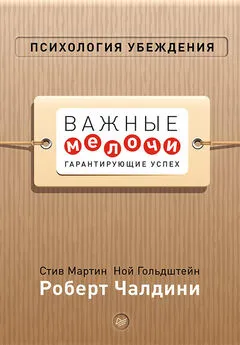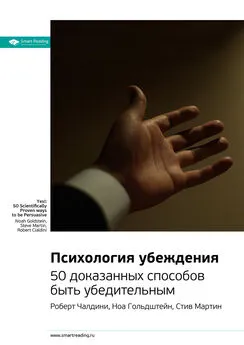Роберт Чалдини - Психология влияния
- Название:Психология влияния
- Автор:
- Жанр:
- Издательство:неизвестно
- Год:2001
- ISBN:нет данных
- Рейтинг:
- Избранное:Добавить в избранное
-
Отзывы:
-
Ваша оценка:
Роберт Чалдини - Психология влияния краткое содержание
«Психологию влияния» знают и рекомендуют в качестве одного из лучших учебных пособий по социальной психологии, конфликтологии, менеджменту все западные, а теперь уже и отечественные психологи. Книга Роберта Чалдини выдержала в США четыре издания, ее тираж превысил полтора миллиона экземпляров. Эта работа, подкупающая читателя легким стилем и эффектной подачей материала, является тем не менее серьезным трудом, в котором на самом современном научном уровне анализируются механизмы мотивации, усвоения информации и принятия решений.
Нет сомнения, что данная книга не только займет достойное место в библиотеке социального психолога, но и поможет в работе менеджерам, педагогам, политикам, всем, кто по роду деятельности должен убеждать, воздействовать, оказывать влияние.
Роберт Чалдини – профессор психологии Аризонского университета в Темпле, специалист в области экспериментальной и социальной психологии.
«Самая информативная и увлекательная работа из всех когда-либо написанных о влиянии людей друг на друга».
Дэвид Майерс, профессор психологии
«С полным основанием можно сказать, что в этой книге найдут для себя много интересного и поучительного все те, кому приходиться постоянно общаться по роду своей деятельности с широким кругом самых разных людей».
А. Л. Свенцицкий, доктор психологических наук, профессор СПбГУ
Психология влияния - читать онлайн бесплатно ознакомительный отрывок
Интервал:
Закладка:
Latane B. &Darley J. M. ( 1968a). Group inhibition of bystander intervention in emergencies. Journal of Personality and Social Psychology, 10, 215-221.
Latane B. &Darley J. M. (1968b). The unresponsive bystander: Why doesn’t he help? New York: Appleton-Century-Crofts.
Latane B. &Nida S. (1981/ Ten years of research on group size and helping. Psychological Bulletin, 89, 308-324.
Latane B. & Rodin J. (1969). A lady in distress: Inhibiting effects of friends and strangers on bystander intervention. Journal of Experimental Social Psychology, 5,189-202.
Laughlin P. R. (1980). Social combination processes in cooperative problem-solving groups in verbal intellective tasks. In M. Fishbein (Ed.), Progress in social psychology. Hills-dale, NJ: Lawrence Erlbaum.
Leakey R. &Lewin R. (1978). People of the lake. New York: Anchor Press/Doubleday.
Lefkowitz M., Blake R. R. & Mouton J. S. (1955). Status factors in pedestrian violation of traffic signals. Journal of Abnormal and Social Psychology, 51,704-706.
Leippe M. R. & Elkin R. A. (1987). When motives clash: Issue involvement and response involvement as determinants of persuasion. Journal of Personality and Social Psychology, 52, 269-278.
Lepper M. R. & Greene D. (Eds.). (1978). The hidden costs of reward. Hillsdale, NJ: Lawrence Erlbaum.
Levine L. E. (1983). Mine: Self-definition in two-year-old boys. Developmental Psychology, 19, 544-549.
Lewis M. &Brooks-Gunn J. (1979). Social cognition and the acquisition of self. New York: Plenum.
Liebert R. & Baron R. A. (1972). Some immediate effects of televised violence on children’s behavior. Developmental Psychology, 6,469-475.
Lloyd J. E. (1965). Aggressive mimicry in Photuris: Firefly femme fatales. Science, 149, 653-654.
Locke K. S. & Horowitz L. M. (1990). Satisfaction in interpersonal interactions as a function of similarity in level of dysphoria. Journal of Personality and Social Psychology, 58,823-831.
Lott A.J. &Lott B. E. (1965), Group cohesiveness as interpersonal attraction: A review of relationships with antecedent and consequent variables. Psychological Bulletin, 64, 259-309.
Lynn M. (1989). Scaricity effect on value: Mediated by assumed expensiveness. Journal of Economic Psychology, 10,257-274.
Lynn M. & Shurgot B.A.( 1984). Responses to lonely hearts advertisements: Effects of reported physical attractiveness, physique, and coloration. Personality and Social Psychology Bulletin, 10,349-357.
Lytton J.(ld79). Correlates of compliance and the rudiments of conscience in two-year-old boys. Canadian Journal of Behavioral Science, 9,242-251.
Mack D. & Rainey D. (1990). Female applicants’ grooming and personnel selection. Journal of Social Behavior and Personality, 5,399-407.
MacKenzie B. (1974, June 22). When sober executives went on a bidding binge. TV Guide. Mackworth N. H. ( 1965). Visual noise causes tunnel vision. Psychonomic Science, 3,67-68. Macrae N. (1972, January 22). Multinational business. The Economist.
Magruder J. S. (1974). An American life: One man’s road to Watergate. New York: Athene-urn.
Mahler M. S., Pine F. & Bergman A. (1975). The psychological birth of the infant. New York: Basic Books.
Major В., Canington P. L & Carnevale P.J. D. (1984). Physical attractiveness and self-esteem: Attributions for praise from an other-sex evaluator. Personality and Social Psychology Bulletin, 10,43-50.
Manis M., Cornells D. & Moore J. C. (1974). Transmission of attitude relevant information through a communication chain. Journal of Personality and Social Psychology, 30, 81-94.
Markus H. &Kitayama 5. (1991). Culture and the self: Implications of cognitions, emotion and motivation. Psychological Bulletin, 98, 224-253.
Maruyama G., Miller N. & Holtz R. (1986). The relation between popularity and achievement: A longitudinal test of the lateral transmission of value hypothesis. Journal of Personality and Social Psychology, 51, 730-741.
Mauro R. (1984). The constable’s new clothes: Effects of uniforms on perceptions and problems of police officers. Journal of Applied Social Psychology, 14,42-56.
Mauss M. (1954). The gift. (I. G. Cunnison, Trans.). London: Cohen and West.
Mazis M.B. (1975). Antipollution measures and psychological reactance theory: A field experiment. Journal of Personality and Social Psychology, 31,654-666.
Mazis M. В., Settle R. B. & Leslie D. C. (1973). Elimination of phosphate detergents and psychological reactance. Journal of Marketing Research, 10,390-395.
McCall M., &Belmont H.J. (1996). Credit card insignia and restaurant tipping: Evidence for an associative link. Journal of Applied Psychology, 81,609-613.
McCombs M. & Zhu J. (1995). Capacity, diversity, and volatility of the public agenda. Public Opinion Quarterly, 59,495-525.
McGuinnies E. & Ward C. D. (1980). Better liked than right: Trustworthiness and expertise as factors in credibility. Personality and Social Psychology Bulletin, 6,467-472.
Meeus W. H.J. & Raaijmakers Q. A. W. (1986). Administrative obedience: Carrying out orders to use psychological-administrative violence. European Journal of Social Psychology, 16,311-324.
McGuinnies E. & Ward C. D. (1980). Better liked than right: Trustworthiness and expertise as factors in credibility. Personality and Social Psychology Bulletin, 6,467-472.
Melamed B. F., Yurcheson E., Fleece L., Hutcherson S. & Hawes R. (1978). Effects of film modeling on the reduction of anxiety-related behaviors in individuals varying in level of previous experience in the stress situation. Journal of Consulting and Clinical Psychology, 46,1357-1374.
Meyerwitz B. E. & Chaiken S. (1987). The effect of message framing on breast self-examination attitudes, intentions, and behavior. Journal of Personality and Social Psychology, 52, 500-510.
Meyerwitz B. E., Wilson D. K. & Chaiken S. (1991). Loss-framed messages increase breast self-examination for women who perceive risk. Paper presented at the meeting of the American Psychological Society, Washington, D. C.
Milgram S. (1963). Behavioral study of obedience. Journal of Abnormal and Social Psychology, 67, 371-378.
Milgram S. (1970). The experience of living in cities. Science, 13,1461-1468.
Milgram S. (1974). Obedience to authority. New York: Harper & Row.
Milgram S., Bickman L. & Berkowitz O. (1969). Note on the drawing power of crowds of different size. Journal of Personality and Social Psychology, 13,79-82.
Milgram S. & Sabini J. (1975). On maintaining norms: A field experiment in the subway. Unpublished manuscript, City University of New York.
Miller N.. Campbell D. Т., Twedt H. & 0 ’Cornell E.J. (1966). Similarity, contrast, and complementarity in friendship choice. Journal of Personality and Social Psychology, 3,3-12.
Miller N., Maruyama G., Beaber R.J. & Valone K. (1976). Speed of speech and persuasion. Journal of Personality and Social Psychology, 34, 615-625.
272 Глава 8
Miller R. L, Seligman C., Clark N. T. & Bush M. (1976). Perceptual contrast versus reciprocal concession as mediators of induced compliance. Canadian Journal of Behavioral Science, 8,401-409.
Mills J. & Clark M. 5. (1982). Exchange and communal relationships. In L. Wheeler (Ed.), Review of personality and social psychology (Vol. 3). Beverly Hills, CA: Sage.
Mita T. H., Denner M. & Knight J. (1977). Reversed facial images and the mere exposure hypothesis. Journal of Personality and Social Psychology, 35, 597-601.
Moriarty T. (1975). Crime, commitment, and the responsive bystander. Journal of Personality and Social Psychology, 31,370-376.
Morrow L. (1991, September, 2). The Russian revolution. Time, p. 20.
Murphy S. T. & Zaionc R. B. (1993). Affect, cognition awareness. Journal of Personality and Social Psychology, 64, 723-739.
Murray D. A., Leupker R. V., Johnson C.A. & Mittlemark M. B. (1984). The prevention of cigarette smoking in children: A comparison of four strategies. Journal of Applied Social Psychology, 14, 274-288.
Newcomb T. (1953). An approach to the study of communicative acts. Psychological Review, 60, 393-404.
News. (1988). Stanford Business School Magasine, 56, 3.
Nosanchuk T.A. & Lightstone J. (1974). Canned laughter and public and private conformity. Journal of Personality and Social Psychology, 29,153-156.
O’Connor R. D.( 1972). Relative efficacy of modeling, shaping, and the combined procedures for modification of social withdrawal. Journal of Abnormal Psychology, 79,327-334.
O’Leary S. G. (1995). Parental discipline mistakes. Current Directions in Psychological Science, 4, 11-13.
Olson J. C. (1977). Price as an informational cue: Effects of product evaluations. In A. G. Wood-side, J. N. Sheth, & P. D. Bennett (Eds.), Consumer and industrial buying behavior. New York: North-Holland.
Oscamp S. & Schultz P. W. (1998). Applied Social Psychology. Englewood Cliffs, NJ: Prentice-Hall.
Overload of advice likely misled FBI (1993, October, 8). Arizona Republic, p. A13. Packard V. (1957). The hidden persuaders. New York: D. McKay Co.
Paese P. & Gilin D. A. (2000). When an adversary is caught telling the truth. Personality and Social Psychology Bulletin, 26, 75-90.
Pallak M.S., Cook D. A. & Sullivan J.J. (1980). Commitment and energy conservation. Applied Social Psychology Annual, 1, 235-253.
Pardini A. & Katzev R. (1983-1984). The effect of strength of commitment on newspaper recycling. Journal of Environmental Systems, 13, 245-254.
Paulhus D. L., Martin C. L. & Murphy G. K. (1992). Some effects of arousal sex stereotyping. Personality and Social Psychology Bulletin, 18,325.
Peiponen V. A. (1960). Verhaltensstudien am blaukehlchen [Behavior studies of the bluethroat]. Ornis Fennica, 37, 69-83.
Peters D. P. & Ceci S.J. (1982). Peer-review practices of the psychological journals: The fate of published articles, submitted again. The Behavioral and Brain Sciences, 5,187-195.
Petty R. E. & Cacioppo J. T. (1986). The elaboration likelihood model of persuasion. In L. Berkowitz (Ed.), Advances in experimental social psychology: Vol. 19 (pp. 123-205). New York: Academic Press.
Petty R. E., Cacioppo J. T. & Goldman R. (1981). Personal involvement as a determinant of argument-based persuasion. Journal of Personality and Social Psychology, 41, 847-855.
Phalen C. W., Chairperson. (1951). [Panel discussion of N.I.C. Public Relations Committee]. Yearbook. New York: National Interfraternity Conference.
Phillips D. P. (1974). The influence of suggestion on suicide: Substantive and theoretical implications of the Werther effect. American Sociological Review, 39,340-354.
Phillips D. P. (1979). Suicide, motor vehicle fatalities, and the mass media: Evidence toward a theory of suggestion. American Journal of Sociology, 84,1150-1174.
Phillips D. P. (1980). Airplane accidents, murder, and the mass media: Towards a theory of imitation and suggestion. Social Forces, 58,1001-1024.
Phillips D. P. (1983). The impact of mass media violence on U.S. homicides. American Sociological Review, 48, 560-568.
Читать дальшеИнтервал:
Закладка:










